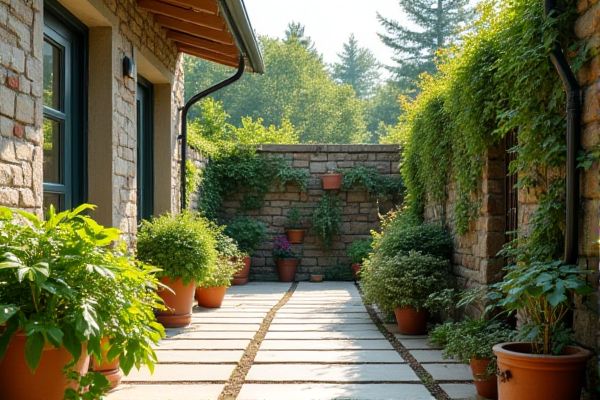
Drip irrigation delivers precise water directly to the roots, conserving water and promoting healthy plant growth, while self-watering pots maintain consistent moisture levels through a built-in reservoir, reducing the need for frequent watering on your terrace. Explore the full article to discover which method best suits your gardening needs and lifestyle.
Table of Comparison
| Feature | Drip Irrigation | Self-Watering Pots (Terrace) |
|---|---|---|
| Water Efficiency | High; delivers water directly to soil, reducing evaporation | Moderate; stores water in reservoir, reduces watering frequency |
| Installation | Requires setup of tubes and emitters | Plug and play; minimal setup |
| Maintenance | Needs regular system checks and emitter cleaning | Simple; refill reservoir and occasional cleaning |
| Best Use | Large or multiple plants on terraces or gardens | Individual plants in limited terrace space |
| Cost | Higher initial investment | Lower initial cost |
| Water Source | Connected to water supply or tank | Manual filling of reservoir |
| Automation | Supports timers and sensors | Generally manual |
Introduction to Terrace Gardening Irrigation Methods
Drip irrigation systems provide precise water delivery directly to plant roots, minimizing water waste and promoting healthy terrace garden growth. Self-watering pots use a reservoir to keep soil consistently moist, making them ideal for low-maintenance urban terrace setups. Your choice between drip irrigation and self-watering pots depends on your terrace garden's size, plant variety, and watering frequency requirements.
Overview of Drip Irrigation Systems
Drip irrigation systems deliver water directly to plant roots through a network of tubes and emitters, minimizing water waste and promoting efficient moisture distribution on terraces. These systems can be automated with timers, ensuring consistent watering tailored to your plants' needs and local climate. Compared to self-watering pots, drip irrigation covers larger areas and supports diverse plant arrangements with precise control over water flow and frequency.
Introduction to Self-Watering Pots for Terraces
Self-watering pots for terraces offer a practical solution for urban gardeners seeking efficient water management by combining a reservoir system that supplies consistent moisture to plants, reducing the risk of over- or under-watering. Unlike drip irrigation, which delivers water directly to the soil through emitters and requires a more complex setup, self-watering pots are compact and ideal for limited terrace spaces while promoting healthy root growth through a capillary action system. These containers enhance water-use efficiency and minimize maintenance, making them particularly suitable for balcony gardens, small terraces, and container-grown plants.
Installation and Setup: Drip Irrigation vs Self-Watering Pots
Drip irrigation systems require precise installation involving tubing, emitters, and a water source connection, often demanding professional setup for optimal efficiency. Self-watering pots feature a built-in reservoir that simplifies setup, requiring only soil placement and occasional water refills without complex plumbing. The ease of installation with self-watering pots makes them ideal for urban terraces, while drip irrigation suits larger or more diverse terrace gardens needing automated, targeted watering.
Water Efficiency and Conservation Compared
Drip irrigation systems deliver water directly to the plant roots with minimal evaporation, ensuring higher water efficiency compared to self-watering pots, which rely on soil moisture reservoirs and can sometimes lead to overwatering or uneven hydration. You can achieve precise control over water distribution with drip irrigation, making it ideal for conserving water in terrace gardens where water resources are limited. Self-watering pots, while convenient for maintaining moisture, generally use more water overall due to evaporation from exposed reservoirs and less targeted watering.
Plant Health and Growth Benefits
Drip irrigation ensures precise water delivery directly to plant roots, promoting consistent soil moisture and reducing the risk of overwatering, which enhances nutrient uptake and drives robust plant growth. Self-watering pots use a reservoir system that maintains optimal hydration levels, preventing root rot and minimizing water stress, resulting in healthier root development. Both systems improve plant health by supporting consistent moisture availability but drip irrigation offers greater control over water distribution for diverse terrace gardens.
Maintenance Requirements of Each System
Drip irrigation systems require regular inspection of emitters and tubing to prevent clogging and leaks, ensuring consistent water delivery to your terrace plants. Self-watering pots demand less frequent intervention but need periodic refilling of the reservoir and monitoring for algae growth or root rot. Your choice depends on the balance between convenience and control over water distribution in your urban garden.
Cost Analysis: Initial and Long-Term Expenses
Drip irrigation systems typically require higher initial investments for equipment like tubing, emitters, and timers, but offer cost-efficiency over time through water conservation and consistent plant hydration. Self-watering pots involve moderate upfront costs due to their integrated water reservoirs, reducing the need for frequent watering and minimizing water waste. Over the long term, drip irrigation's scalability and automation provide economic benefits for larger terraces, while self-watering pots offer a low-maintenance, cost-effective solution for smaller or container-based gardening setups.
Suitability for Different Terrace Garden Sizes
Drip irrigation systems excel in large terrace gardens by providing precise water delivery to numerous plants with minimal waste, enhancing water efficiency for expansive setups. Self-watering pots are ideal for smaller terrace spaces or container gardens, offering consistent moisture to individual plants without complex installation, making them user-friendly for those with limited area. Your choice depends on terrace size; larger gardens benefit from automated drip systems, while compact spaces thrive with easy-maintenance self-watering pots.
Choosing the Best Irrigation Method for Your Terrace
Drip irrigation systems provide precise water delivery directly to the roots, minimizing water waste and ensuring consistent moisture for terrace plants. Self-watering pots feature built-in reservoirs that allow plants to draw water as needed, reducing maintenance and preventing overwatering. Selecting the ideal irrigation method depends on factors like plant variety, watering frequency, terrace size, and ease of system installation.
 homyna.com
homyna.com